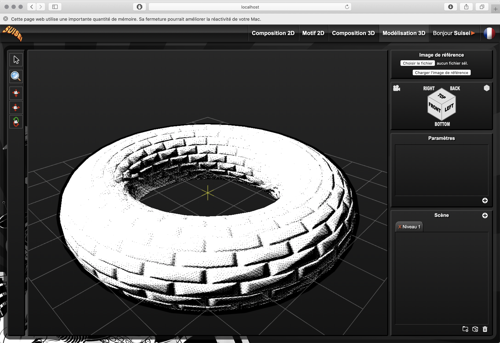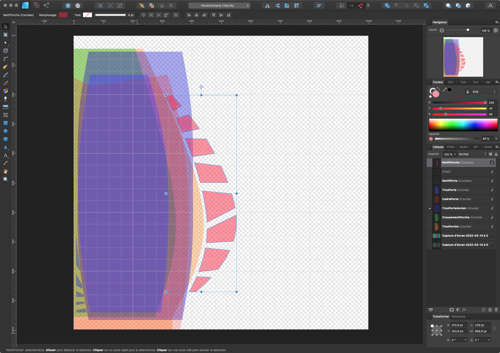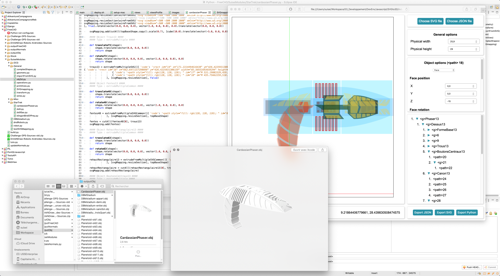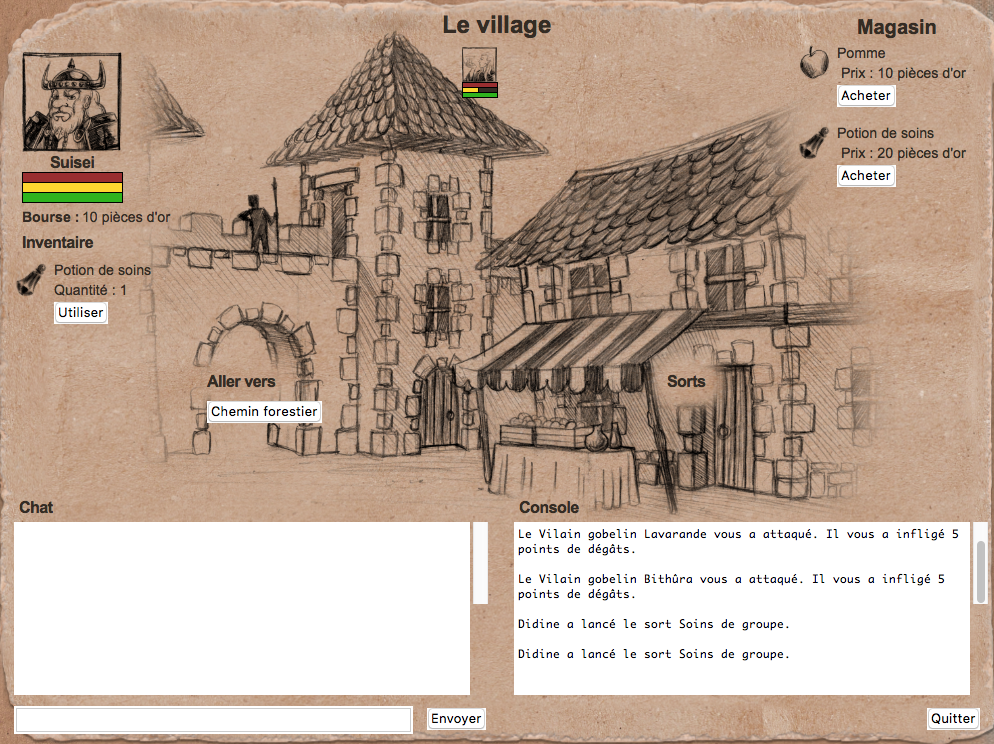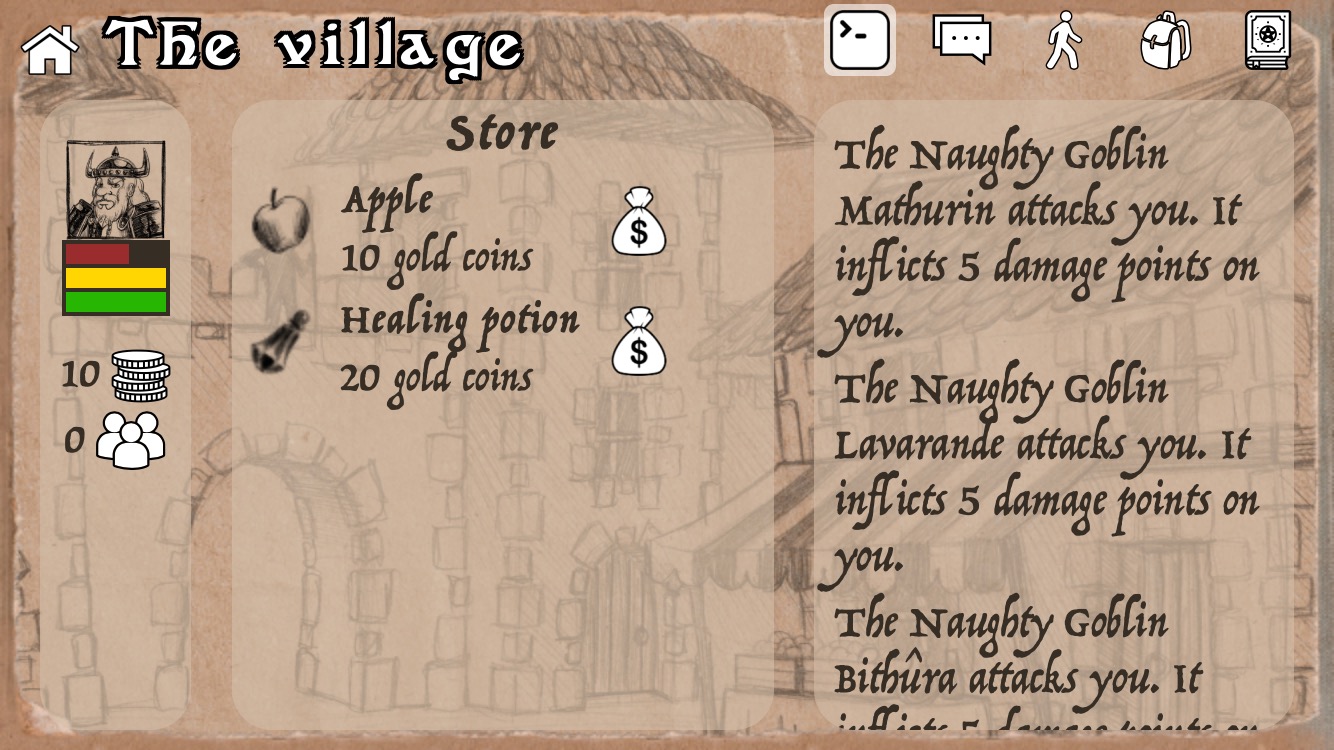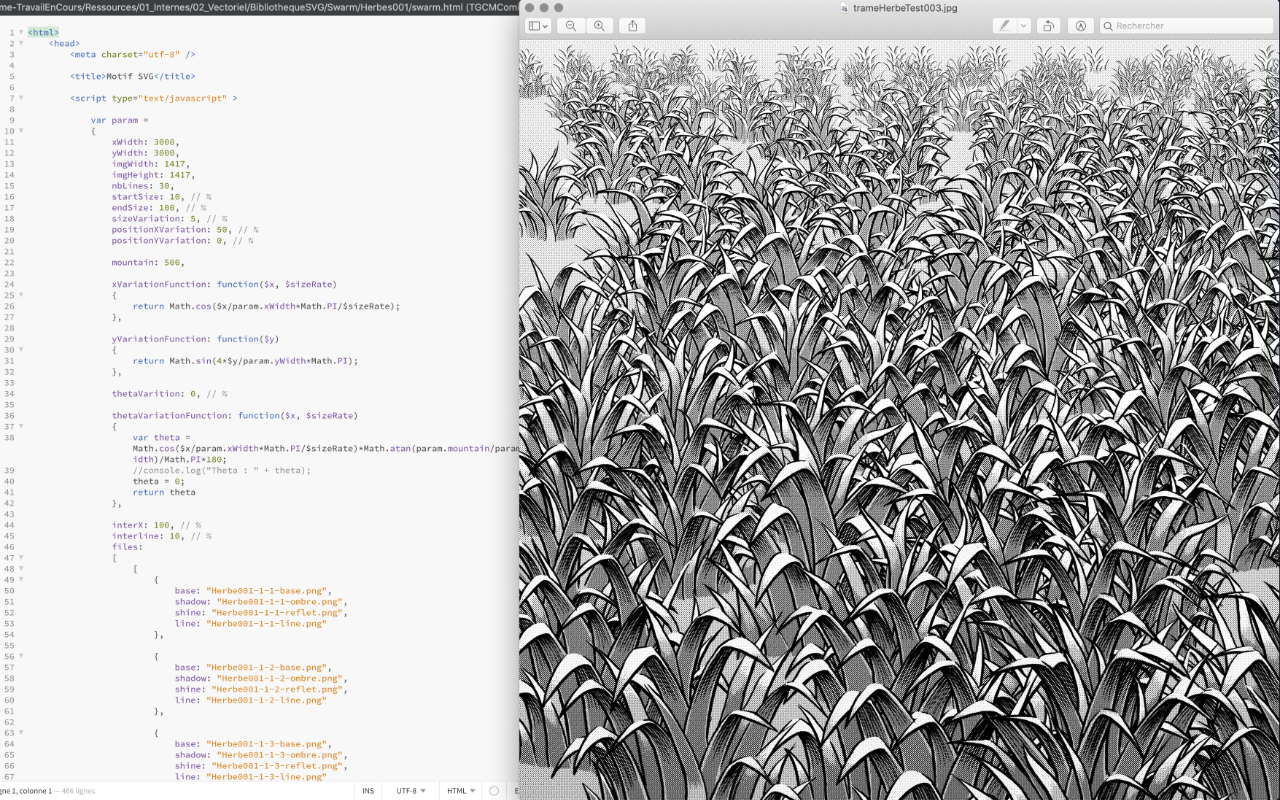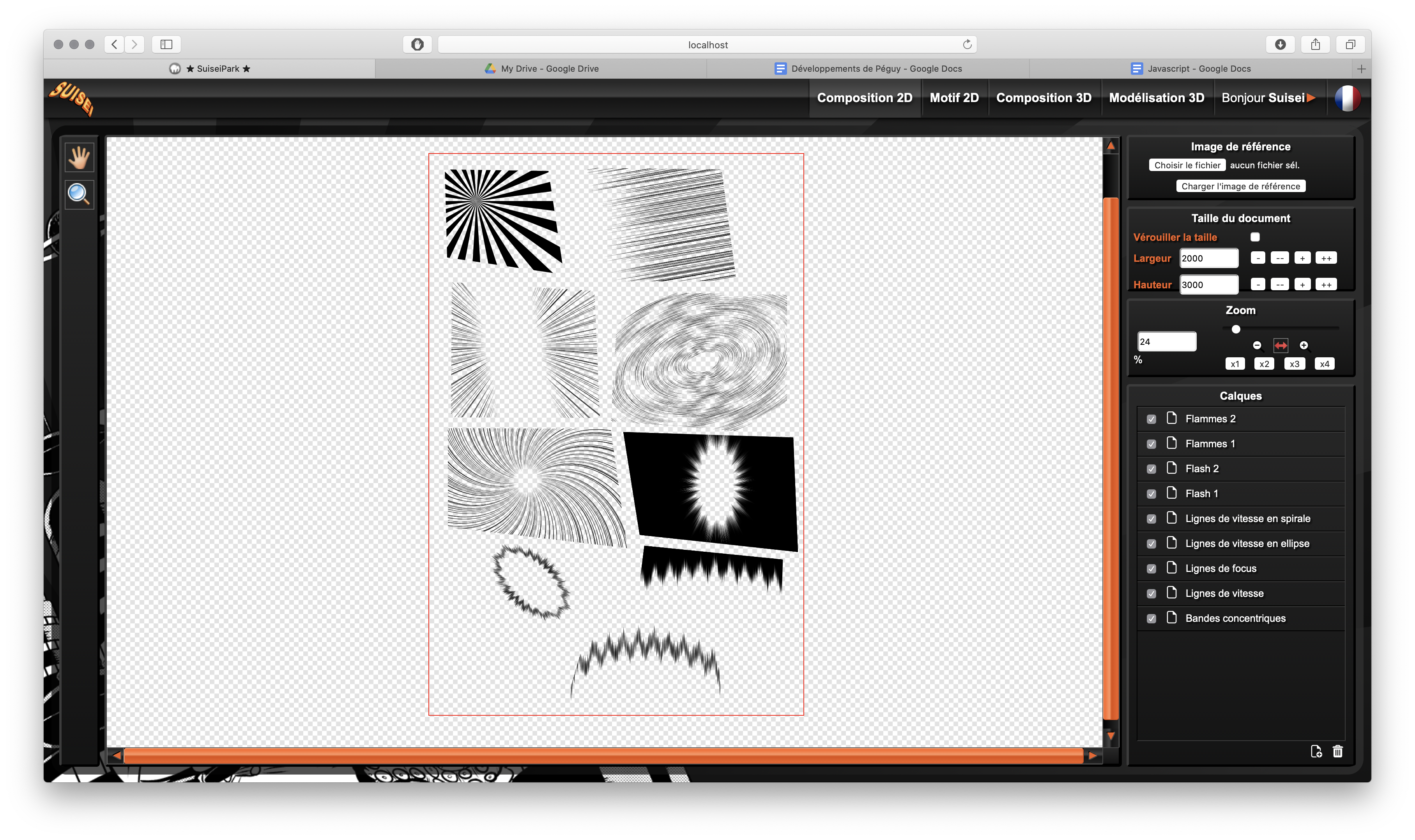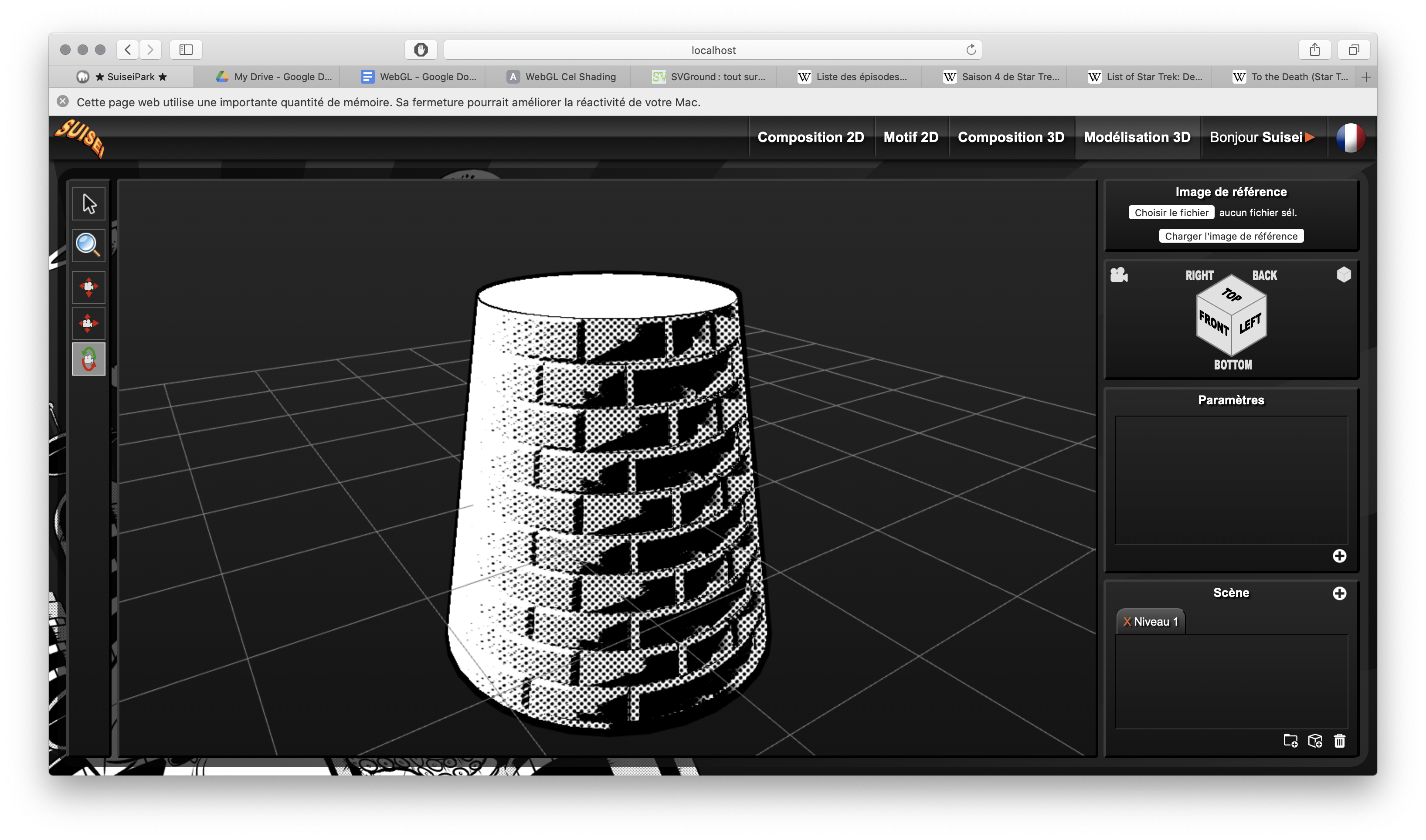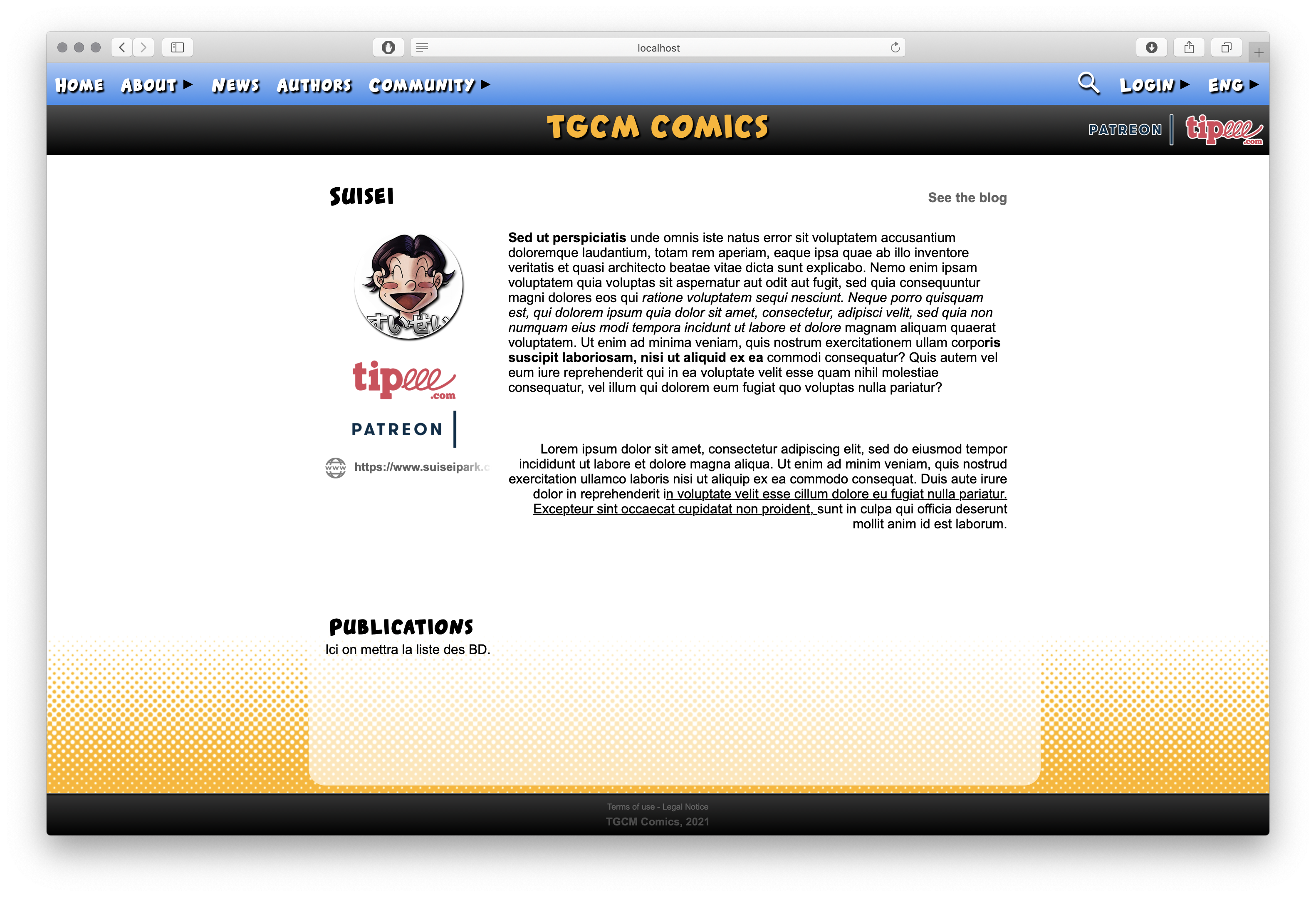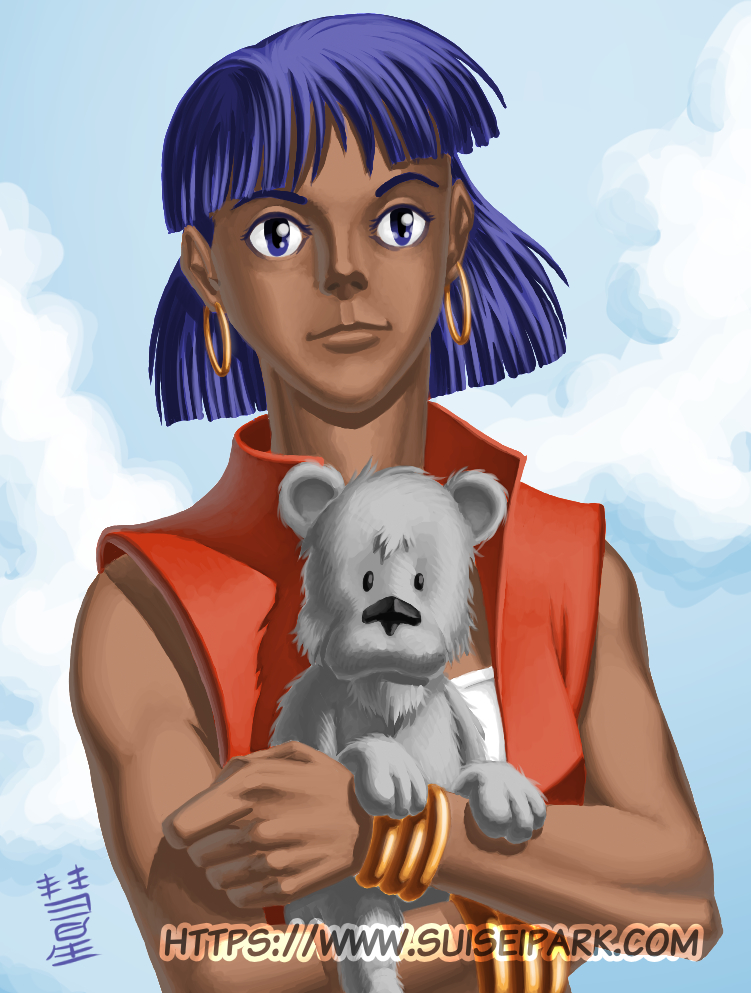News
Dragon Ball Multiverse chapter 84, behind the scenes
Published by Suisei at 21/03/2022 à 20h15
Hi everyone!
As mentioned in the in review 2021, today I'm going to tell you a little bit about the behind-the-scenes of my participation to the collective fan comic Dragon Ball Multiverse.
For those who are new to this, you can read the full comic here.
The chapter I participated in starts here.
This chapter was originally supposed to be drawn by the Korean artist Ume.
But health problems didn't allow her to finish it, so I took over to help out.
Since it was drawing a match involving two of my favorite characters (Vegeta and Cell), I did let Salagir (the writer and creator of DBM) know that I was available if they needed a hand. x)
Let's start briefly with the cover.
At first, it was just a fanart referring to the match between Vegeta and Cell.
I did the drawing with the traditional method, with a brush for the inking, and then I did the color on computer with Clip Studio Paint and Affinity Photo.
I wanted to try something close to the American comics for the color.
Finally, as no cover had been made for the chapter, I proposed this illustration and Salagir thought it would do the trick.
Now I will detail a little more the working process used on the pages themselves.
First, Salagir provides a script on Google Doc with layout indications.
Then I draw each panel separately on scrap paper instead of trying to pencil the whole page in one block.
After that, I put all the drafts together in Clip Studio Paint.
For the pages where we see the scenery, I modeled the tournament stadium with one of my Python and FreeCAD programs and used it as a base to draw faster.
Here, I visualize the result in Blender to make sure that the result is correct.
The 3D stadium was used for this page for example.
Then, once the drafts are put together and corrected in Clip Studio Paint, I ink digitally, then load the page into my Péguy application to generate the speed or shock effects.
And then I come back to Clip Studio Paint to apply the final touch.
Now you know the secrets of the making of chapter 84 of Dragon Ball Multiverse, at least the part I made. :D
This news marks the end of the early 2022 batch.
I'm not sure yet when and what the next one will be about, but I'll try to make an effort to be more regular. :p
On that note, I wish you a nice week and see you soon!
Suisei
Categories : Comics, News and chitchat,
Péguy's progress
Published by Suisei at 14/03/2022 à 20h15
Hi everyone!
As mentioned in the in review 2021, today I'm going to talk more about the progress of the Peguy project.
We're going to talk about 3D and programming, so this is a news that will be relatively technical.
Let's go!
The application Péguy
As said before, I haven't made much progress on the application itself since the last time.
It has been enriched with a few more effects and new possibilities for modeling shapes.
But not much more.
I did a lot of research on the different methods of automatic texturing on a sphere.
Going from a 2D image to a spherical volume is not an easy task!
I added the possibility to define holes in the textures.
The revolution function: it allows to draw a 3D object from a 2D curve by simple rotation around an axis.
Any 3D modeling software worthy of the name must offer it.
Extrusion from a 2D shape. This is also a must-have feature.
New primitives (basic geometric shapes).
A little donut for the road?
On the other hand, I did a lot of research and also developed small independent tools that will be interesting to integrate into the application in the future.
FreeCAD and the Python language
In January 2021, my dad decided to learn 3D modeling so that he could model small mechanical parts to be manufactured by online 3D printing services.
The idea was to be able to replace small broken or lost parts.
The software he started using for this is called FreeCAD.
It is a free and open source computer-aided design (CAD) software.
It is a technical software. It is designed to model mechanical parts, architecture, but not really to make art (video game, animation, illustration... all that).
For my comics, I'm interested in using 3D for architectural scenery or vehicles, I thought it would be interesting to take a look at it...
Just out of curiosity...
While doing my research, I discovered that the software was customizable with scripts or plugins written with the Python language, like many 3D softwares.
But the most interesting thing is that FreeCAD functions can be called from an independent Python program without opening FreeCAD!
I really found this very interesting, so I rushed to do some tests.
This is one of my very first tests.
It was sculpted using the boolean principle.
Basically, the idea is to create shapes by adding or subtracting simpler ones from each other or by taking the intersection of 2 shapes.
This little diagram found on Wikipedia is more telling than long words.
Until now I had never really gotten serious about 3D modeling because the software I had studied up until then was more for art. When I wanted to model objects or structures whose geometry I knew with mathematical accuracy, I was very frustrated by the imprecision of these software.
The problem was that they didn't allow you to express shapes by entering custom mathematical formulas and you had to struggle to do things freehand that could have been quick and easy with a little math.
The idea of making 3D generation programs where I am not hindered by a user interface quickly became apparent.
I had started to study the subject with Java.
Since I discovered FreeCAD, I have developed lots and lots of programs with it.
Sets and ships for the Star Trek webtoon project.
Robots and planetoids.
Vector drawing
The other revelation of the year in 3D modeling was... 2D vector drawing!
Yes! Who would have thought it? A 2D tool!
In fact, I quickly realized that if I just entered mathematical formulas and numbers in my head or with 2 or 3 calculations on a corner of the table, I would quickly hit a snag.
How to deal with more complex shapes, especially curves?
So I quickly wondered if there was a way to import vector drawing files into a program using FreeCAD.
And the answer is YES :D
In 2020 I took advantage of a promotion to buy the Affinity Designer software, but I wasn't sure how to use it.
Well, since I discovered the possibility of using vector drawing in 3D, I use it all the time. 8D
Now my method is to draw 2D plans of my objects and convert them into 3D objects, either by extrusion or by revolution, either with FreeCAD or with Blender.
The wing pattern of the Klingon bird-of-prey is a typical example of what I couldn't do with just lines of code.
The door of the sickbay of Deep Space Nine was modeled on the same principle but with Blender instead of FreeCAD and Python.
This is the tournament arena in Dragon Ball Multiverse.
I modeled its main structure by applying a revolution from a curve I drew in Affinity Designer.
Small independent applications
Well, coding everything by hand and declaring one by one all the vector files imports can sometimes be laborious, and above all, it's perfectly unusable for the general public.
So, I started to code little tools that allow me to make the link between my vector drawing files and my Python programs.
Eventually, the idea is to combine my FreeCAD programs with my interfaces developped with web technologies.
This little tool allows me to load a vector file and to associate to each 2D element parameters that allow to define which transformation will convert it into 3D.
As it is, it generates a Python program.
Then, I copy and paste this program to run it and generate a 3D object.
Nodal languages
In the Péguy project there are 2 ideas that I wanted to develop.
The first, an interface accessible to the general public that can be used like a Lego set.
The second, a graphical programming interface to create more complex and dynamic objects reserved for more experienced users.
At first I was planning to use the event scheduling system of RPG Maker as a model.
But after some research and some exchanges with friends who also practice 3D, I discovered that there was software based on this principle: a graphical programming language in the form of nodes that can generate complex scenes in an automated way with great freedom.
The most famous in the field is called Houdini and is widely used to generate special effects in movies among others.
There is a free version to learn how to use it, but as soon as you want to use it for commercial projects, the price stings!
It's a product that is aimed at companies and not at small independent artists.
I will surely study it out of curiosity.
While wandering around itch.io I found a small open source tool based on the same principle but much simpler.
This software is called Sceelix.
This example is provided directly with the software.
Well, it doesn't seem to be really maintained anymore and it's a bit broken.
I only managed to run it on a Windows 10 virtual machine and another Ubuntu 20 and even then it was a bit buggy.
But on Mac OS X, on other versions of Windows or Linux, it crashed.
In short! It's interesting to study the concept but it seems to me hardly usable as it is.
And then recently, there's good old Blender which has integrated geometry nodes which are based on the same principle.
I haven't looked into it yet, but knowing the node system for materials, the current quality of Blender's interface, and seeing the captures of work done with geometry nodes on the internet, I think it's a powerful tool.
I'll be sure to take a closer look.
Having said that, after a quick exploration, it still seems to lack some existing node types in the 2 previous tools, namely if blocks or for loops.
When you're used to programming for a long time like me, having to do without them and tinkering with them to be able to emulate them quickly overloads the interface with the number of nodes.
In summary, there are two possible approaches: either the nodal model which is currently the most commonly used in 3D software, or the RPG Maker approach which looks more like a written program and has less risk of becoming messy and unreadable.
If you have an opinion on the subject, I am all ears.
Blender
In absolute terms, since its last versions released during the year 2021, Blender is now able to do most of the things I'm looking to do with the Péguy project, at least for the 3D part (not for the 2D part).
Most of them...
I've been training intensively in Blender for about 5 months now and there are shapes that I could do with my Python programs that I still can't do in Blender, even with plugins.
3D CAD tools still have some little tricks in terms of pure modeling that artistic 3D softwares don't have yet.
So, for my own use, Blender would do the trick by combining it from time to time with Affinity Designer, FreeCAD and some Python scripts.
But doing all this with general 3D software like Blender is devilishly technical and is clearly not accessible to everyone.
If you're not a bit of a mathematician, mastering raster and other manga effects in general 3D software is not an option.
And I know that many comic artists are alergic to math and technique. :p
Black and white and color comic book renderings.
And to do this, nodes, with sub-nodes and sub-sub-nodes...
This gives me a more precise idea of how to orientate the Péguy project: to specialize it for comics, or even illustration, and make it accessible to non-technical profiles.
Roadmap
Now that I have a clearer idea of what I am going to do, here is how I plan to do it.
The first step will be to make a first version only with the 2D features (including the manga effects you already know).
I found that the vector drawing really helped me so I think it's important to make it a central part of the project.
Moreover, if nodal languages are multiplying to do procedural 3D, I have not yet found an equivalent in vector drawing.
I think it could be really interesting to explore this idea.
The 3D will come in a second time.
The overall philosophy will be to ensure accessibility to non-technical profiles, that it is a lego game for them, but also to offer a little more to the more comfortable users.
Well, I think I've covered it all the subject.
I realize that I've explored a lot of things over the past year when it comes to 3D.
It's a fascinating subject. :D
Okay! I'll stop bothering you.
I wish you a nice week and see you soon!
Suisei
Categories : 3D, Graphic research, News and chitchat,
Update of Go on an Adventure Comrades!
Published by Suisei at 07/03/2022 à 20h15
Updated by Suisei at 26/02/2022 à 22h09
Hi everyone!
As mentioned in the in review 2021, last spring I did a big update to the game!
I should have made the announcement back then, but... I had a terrible laziness to write news for a long time. I preferred to spend my meager free time coding, doodling, modeling. :p
So! This update.
It consists of 2 important points.
No need to download the game
Indeed, with the previous version you needed to download the client of the game.
It was not very sexy because the native python graphics module is very limited.
Now you can play it directly from your browser! :D
Nothing to download or install.
All you have to do is click on the Play link on the game page.
Or you can simply click here to go directly to the game screen.
On the left, it was before the update, on the right, it is after.
In my short career as a developer, I have never found better than web technologies to be able to make beautiful user interfaces that are fast, pretty and flexible.
As a bonus, the game is also compatible with mobiles!
You can really play it from anywhere now (as long as you have internet access)! :D
Hosting of the server
The second point is more technical.
Before, the game server was running on my home computer, so you could only play if it was turned on and connected to the Internet in my home.
Those days are over!
From now on, the server is running on a professional host with automatic backups, so the game is always accessible! :D
As a bonus for me, it will have been a good exercise for future online game projects that are in development.
I wish you a nice week and see you soon for new adventures!
Suisei
Categories : Games, News and chitchat,
Review of the year 2021
Published by Suisei at 28/02/2022 à 20h15
Hello everyone!
It's been a long time since I've given any news.
I have been very busy these last months.
It is therefore time to give some news!
To begin with, it seems that this is the first news of 2022, so, I wish you all a happy new year a little late! :D
Today, we're going to take a look back at a very, very busy year in 2021.
So busy that some of the topics mentioned today will be the subject of separate news in the coming weeks.
Here is a small summary of the topics I will cover.
- Péguy
- 13th Digital Painting School's Challenge
- Illustrations
- TGCM Comics
- Dragon Ball Multiverse
- Blender 3D courses
- The Cardassian Bird-of-Prey
- Update of Go on an Adventure Comrades!
- In conclusion
Péguy
I already told you about this project in a news early last year, an app that allows you to generate a number of patterns and effects in an automated way for comics and mangas.
The application itself has not progressed much since then, but I have done a lot of research on 3D programming and have developed new separate tools to speed up my work processes.
I went beyond web technologies and worked a lot with the Python language.
Now I have to think of a way to put all this together in an intelligent and accessible way for the general public.
New effects in the application
Automated 3D scene generation with the Python language.
We don't need to introduce you to these good old stormtroopers anymore.
An application that generates a program that itself generates a 3D object... Yes, the delirium goes far. x)
The object generated here is a Cardassian weapon (Star Trek).
There is a lot more to say about it, so this topic will be the subject of a more complete news in the coming weeks.
13th Digital Painting School's Challenge
In line with my research for the Peguy project, in the spring of 2021 I participated in a contest organized by Digital Painting School, a French speaking online digital art school.
The proposed theme left quite a bit of creative freedom, so I took the opportunity to submit a drawing not drawn with a pencil or stylus, but drawn with lines of code.
Basically, I wrote a program in Python that generated a robot and a 3D setting.
Then I loaded this 3D scene into Clip Studio Paint and applied some filters to get a color result.
The concept has been quite successful. :p
This project allowed me to develop a bunch of new features that will be usable in Peguy in the future.
The next big DP School challenge is announced for March 2022.
I'm looking forward to it to try new experiences. :D
Illustrations
Pixel Art
Keeping with the illustration theme, last year I did a whole news about the old software of my childhood, AppleWorks and I did a pixel art illustration with for the Drink'N'Draw.
It made me want to explore this style more, but with Clip Studio Paint this time. :D
Feel free to click on the images to see them larger and appreciate the details.
Two Dukats (Star Trek - Deep Space Nine). What? You didn't notice that I really like this character? 8D
The first is a makeover I came up with for a story that takes place in an alternate reality where he loses an eye in battle and becomes a space pirate.
The second one, with the red eyes, was a pretext to test my new graphic tablet... Or testing my new graphic tablet was a pretext to draw him... Who knows. 8D
Kira Nerys and Dukat (Star Trek - Deep Space Nine). I won't tell you the story behind this drawing right now, otherwise it's not funny. I let you imagine. :p
Last May, there was a Drink'N'Draw session about Cowboy Bebop, an anime I really like with great music.
So, I bought a new graphics tablet.
My nomadic wacom was very helpful, but as nomadism is no longer relevant with the virus that we know, making regular data transfers between the tablet and the main computer was becoming restrictive.
So I bought a model width screen to plug into my computer but still small enough to carry on vacation.
I was a Wacom customer for a very long time, but the market has evolved in the last few years and new quality brands have emerged at half the price.
So I invested in an XP-Pen Innovator 16 last spring.
It is the size and weight of an Ituos Pro Large from Wacom.
It is the price of an Intuos Pro Large from Wacom...
But there's the built-in screen too! :p
It's really great and fits my needs perfectly. I work with it all the time since then.
Draw with the mouse!
Well, working with AppleWorks has made me want to do more experiments in the year 2021.
I made drawings with a mouse!
Yes, it's possible and it's not that difficult. ^^
In fact, I took over a technique I had developed when I was 12 or 13 years old, when my parents did not yet have a scanner.
I had no choice but to do my digital drawings with the mouse.
The trick is not to try to draw the lines freehand with the mouse and the pencil tool, but to use the geometric tools, especially the straight line.
At least with the straight line, you only have to worry about 2 things: the starting point of the line and its end point.
Thus, the lack of dexterity is no longer an issue. It doesn't matter which way you go.
And with a succession of straight lines, you can simulate a curve.
That's it! Now you know how to draw with a mouse! :D
You can even do it while wearing mittens. I tested it as a joke, and it still works. x)
I made these 2 drawings with the mouse on AppleWorks during Dragon Ball Multiverse lives on Twitch with the main artist Asura.
I will try again one of these days with a video to show you the work process in more detail.
ArtStation
It took me a long time to get interested, but I recently opened a portfolio on ArtStation.
I was expecting a kind of deviantArt bis, but in fact no, it's better, you're more free to organize the content of your portfolio and you can even show your work process (which is what some profesional artists do and it's very instructive).
The quality of the content, at least the one put on the trending page, is also much more professional.
And above all, it's not full of intrusive social networking features! x)
So, if you want to see my latest illustrations from time to time, my ArtStation gallerya> is updated! :D
Just click on the preview below or click on the Illustrations tab of my website to access it.
TGCM Comics
This project progressed more slowly in 2021 than in 2020, but I continued to work on it anyway.
I went back to the blog space, private messaging and comments interface to make it as ergonomic as possible.
I also added an image manager for each user, so you can illustrate your words when you express yourself without having to look for a third party image host.
I'm also close to finish the comic pages uploader and I'll soon be able to tackle a big piece, but also one of the most interesting of the platform, namely the online layout and lettering system. Yes, you will be able to draw and fill your dialog bubbles directly online with automatic translation from French to English or from English to French! :D
I hope that this little extra will be one of the strong and innovative points of the platform.
Dragon Ball Multiverse
I didn't release any hard copy comics in 2021, but I didn't walk away from the drawing board.
This summer I participated in the realization of about fifteen pages of the collective amateur comic Dragon Ball Multiverse! :D
For those who don't know yet, DBM, it's a fan comic that tells a sequel to Dragon Ball Z.
The story is set 10 years later and does not take into account neither Dragon Ball GT, nor Dragon Ball Super (which did not exist yet when DBM was created).
It was created by Salagir (the writer) and Gogeta Jr in 2008.
Today the main artist is Asura and dozens of other artists participate in the creation of special chapters.
To read the entire comic, it's here!
The chapter I participated in was published during the fall of 2021 and begins here.
I had to get used to Akira Toriyama's style again, which I had hardly practiced for about 20 years.
I'm doing not too bad. little by little it's coming back. x)
A more complete news is planned on the subject.
I will show you the working process I used to make the pages.
You should already know that I have applied all the research I had done until then... Which I have already completed since. :p
The cover of chapter number 84.
Page number 1944.
Blender 3D courses
Speaking of research to improve my work processes, in the early fall of 2021 I started taking an online course about the software Blender.
Blender is a free and open source 3D modeling software.
It is increasingly recognized and used by professional 3D artists.
The course I'm taking is provided by Digital Painting School and focuses on the use of 3D for 2D (illustration, comics...), which is very precisely what I need. :D
I had started a course on this same software 14 years ago.
The interface and ergonomics at that time were absolutely bad!
Things have changed a lot!
Today Blender has become much more pleasant and easy to use and has been enriched with many powerful features.
Now I'm using it all the time. x)
Here are some of the works that I have done or that are still being done as part of the course.
The orange robot is the model that the instructor proposes to make step by step in his videos. The 3 others are original creations.
These first 3 images are finished.
For these last 2 it still lacks the so-called paintover phase which consists of repainting over it in 2D software to break up the 3D look and add the missing details that it would have been too laborious to do directly in 3D. The goal of the work technique is to save time wherever possible.
The Cardassian Bird-of-Prey
Going back to a comic topic, in 2021 I started working with my great accomplice Marialexie on a comic project, more precisely a webtoon, about Star Trek.
More exactly on Star Trek - Deep Space Nine.
It's been a long time that we wanted to do something about Star Trek, which is a universe that is really close to our hearts, and it's while watching Deep Space Nine that we finally had an idea.
Without going into details, we didn't like the way the treatment of some of our favorite characters ended to a frustrating degree, and since the concept of alternate realities has always been part of Star Trek, we decided to imagine one where things would have happened differently.
The fork in the road comes at the end of episode 14 of season 4, when Dukat decides to go fight the Klingons alone.
I pulled out a dirty word a few lines back: webtoon.
What is a webtoon?
Basically it is a comic format optimized for reading on touch screen phones.
The comic panels are read one after the other in vertical scrolling.
It gives a different narrative rhythm than a classic comic and the authors play more and more with the vertical scrolling effect.
The popularity of this format is soaring.
I think that in addition to the convenience of reading on a phone, the addictive effect (which social media well konw) of vertical scrolling associated with the fact of telling a story is a contributing factor.
I've been wanting to try this format for a long time and I thought this project would do just fine.
Since it's not humorous or parodic like Dragon Cat's, it's out of the question to exploit it commercially, so I might as well choose this project for a purely web format.
And as this format is becoming more and more popular, I plan to be able to host it on TGCM Comics, so I need to make sure I have a project like this so that there will be content in the webtoon section when the site launches.
To get an idea of what the project is going to look like and what a webtoon is, there is a prototype that mixes finished and pencil panels available online, you can read it here.
The other objective of this project is to apply all that I have learned and developed before and thus to use 3D massively for the scenery and the ships.
In short! A project to propose content on TGCM Comics and use Péguy and 3D... Everything is linked ! x)
The cover illustration for the project.
I took a lot of inspiration from the Star Trek movies posters to make it.
3D, traditional drawing, digital painting... There is already everything in this image.
Update of Go on an Adventure Comrades!
And finally, let's talk about games!
At the end of last spring I made a major update to my online mini adventure game.
Now you don't need to download the game to play it.
You can play it from your browser.
To do so, just go to the game page and click on Play.
The server is no longer hosted by me, but by a real professional host now. So it is always running.
I will detail a bit more in a dedicated news.
A much neater and sexier web interface than with the python language.
In conclusion
Well, I told you that the year 2021 was very busy. x)
To summarize, this year has been marked by the learning and development of new methods and tools to improve my working process.
The year 2022 should continue along the same way.
Its objectives are:
Finishing the exercises of the Blender courses, finishing the development of TGCM Comics, resuming a more regular rhythm of realization of my comics and finally studying some software of video game creation.
Yes, because developing games entirely from scratch while having to take care of all the technical aspects of simulating the physics and the display system was fine 14 years ago, because it was formative and these creation tools were in their infancy and not very accessible to the general public.
Nowadays almost nobody does that anymore and game creators focus on the content, which makes a game unique, and I would like to do the same.
Anyway! I'm going to spend a lot time learning a lot of things.
On that note, I wish you a nice week and see you soon for new adventures!
Suisei
Categories : 3D, Comics, Graphic research, Illustrations, Games, News and chitchat,
Péguy
Published by Suisei at 05/02/2021 à 15h45
Hi everybody!
In this news feed I've told you a few times about a project I named Péguy. Well today I dedicate a complete article to it to present it to you in more detail but also to show you the new features I brought to it at the beginning of the winter.
It's not the priority project (right now it's TGCM Comics) but I needed a little break during the holidays and coding vector graphics and 3D, it's a little bit addictive like playing Lego. x)
Let's go then!
Péguy, what is it?
It is a procedural generator of patterns, graphic effects and other scenery elements to speed up the realization of my drawings for my comics.
Basically, I enter a few parameters, click on a button, and my program generates a more or less regular pattern on its own.
The first lines of code were written in 2018 and since then, this tool has been constantly being enriched and helping me to work faster on my comics. :D
This project is coded with web languages and generates vector patterns in the format SVG.
In the beginning it was just small scripts that had to be modified directly to change the parameters and run individually for each effect or pattern generated.
Not very user friendly, is it? :’D
This first version was used on episode 2 of Dragon Cat's Galaxia 1/2.
During 2019 I thought it would be more practical to gather all these scripts and integrate them into a graphical user interface. Since then, I have enriched it with new features and improved its ergonomics to save more and more time.
Here is a small sample of what can be produced with Péguy currently.
Graphic effects typical of manga and paving patterns in perspective or plated on a cylinder.
All these features were used on Tarkhan and Gonakin.
I plan to put this project online, but in order for it to be usable by others than me, I still need to fix a few ergonomy issues.
For the moment, to recover the rendering, you still need to open the browser debugger to find and copy the HTML node that contains the SVG.
In other words, if you don't know the HTML structure by heart, it's not practical. 8D
A 3D module!
The 2020 new feature is that I started to develop a 3D module. The idea, in the long run, is to be able to build my comics backgrounds, at least the architectural ones, a bit like a Lego game.
The interface is really still under development, a lot of things are missing, but basically it's going to look like this.
So there's no shortage of 3D modeling software, so why am I making one? What will make my project stand out from what already exists?
First, navigation around the 3D workspace. In short, the movement of the camera.
Well please excuse me, but in Blender, Maya, Sketchup and so on, to be able to frame according to your needs to get a rendering, it's just a pain in the ass!
So I developed a more practical camera navigation system depending on whether you're modeling an object or placing it in a map. The idea is to take inspiration from the map editors in some video games (like Age of Empire).
Secondly, I'm going to propose a small innovation. When you model an object in Blender or something else, it will always be frozen and if you use it several times in an environment, it will be strictly identical, which can be annoying for natural elements like trees for example. So I'm going to develop a kind of little "language" that will allow you to make an object customizable and incorporate random components. Thus, with a single definition for an object, we can obtain an infinite number of different instances, with random components for natural elements and variables such as the number of floors for a building.
I had already developed a prototype of this system many years ago in Java. I'm going to retrieve it and adapt it to Javascript.
And the last peculiarity will be in the proposed renderings. As this is about making comics (especially in black and white in my case), I'm developing a whole bunch of shaders to generate lines, screentones and other hatchings automatically with the possibility to use patterns generated in the existing vector module as textures! :D
What are shaders?
Well, you see the principle of post-production in cinema... (Editing, sound effects, various corrections, special effects... all the finishing work after shooting).
Well, shaders are about the same principle. They are programs executed just after the calculation of the 3D object as it should appear on the screen. They allow to apply patches, deformations, effects, filters...
As long as you are not angry with mathematics, there is only limit to your imagination! :D
When you enter a normal vector in a color variable it gives funny results.
Yes! It's really with math that you can display all these things. :D
Now when you hear a smart guy tell you that math is cold, it's the opposite of art or incompatible with art... it's dry toast, you'll know it's ignorance. :p
Math is a tool just like the brush, it's all about knowing how to use it. :D
In truth, science is a representation of reality in the same way as a painting.
It is photorealistic in the extreme, but it is nevertheless a human construction used to describe nature.
It remains an approximation of reality that continually escapes us and we try to fill in the margins of error over the centuries...
Just like classical painting did.
But by the way? Aren't there a bunch of great painters who were also scholars, mathematicians? Yes, there are! Look hard! The Renaissance is a good breeding ground. x)
In short! Physics is a painting and mathematics is its brush.
But in painting, we don't only do figurative, not only realism, we can give free rein to our inspiration to stylize our representation of the world or make it abstract.
Well like any good brush, mathematics allows the same fantasy! All it takes is a little imagination for that.
Hold, for example, the good old Spirograph from our childhood. We all had one! Well, these pretty patterns drawn with the bic are nothing else than... parametric equations that make the students of math sup/math spe suffer. 8D
Even the famous celtic triskelion can be calculated from parametric equations.
Well, I digress, I digress, but let's get back to our shaders.
Since you can do whatever you want with it, I worked on typical manga effects.
By combining the Dot Pattern Generator and the Hatch Generator but display them in white, I was able to simulate a scratch effect on screentones.
In the traditional way it is an effect that is obtained by scraping the screentones with a cutter or similar tool.
Péguy will therefore be able to calculate this effect alone on a 3D scene. :D
I extended this effect with a pattern calculated in SVG.
So it will be possible to use the patterns created in the vector module as textures for the 3D module!
Here it is a pattern of dots distributed according to a Fibonacci spiral (I used a similar pattern in Tarkhan to make stone textures, very commonly used in manga).
Bump mapping
So this is where things get really interesting. We stay in the shaders but we're going to give an extra dimension to our rendering.
Basically, bump mapping consists in creating a bas-relief effect from a high map. And it gives this kind of result.
The defined object is always a simple cylinder (with 2 radii). It is the shaders that apply the pixel shift and recalculate the lighting thanks to the high map that looks like this.
This texture has also been calculated automatically in SVG. Thus we can dynamically set the number of bricks.
Well, this bas-relief story is very nice, but here we have a relatively realistic lighting, and we would like it to look like a drawing.
So by applying a threshold to have an area lit in white, a second threshold to have shadow areas in black, by applying the screentone pattern to the rest and by adding the hatching that simulates the scraped screentone, here is the result!
It's like a manga from the 80's! :D
I tested this rendering with other screentone patterns: Fibonnacci spiral dots, parallel lines or lines that follow the shape of the object.
Now we know what Péguy can do.
I think I can enrich this rendering a bit more with the shaders but the next time I work on this project the biggest part of the job will be to create what we call primitives, basic geometric objects.
After that I can start assembling them.
The concept of drawing while coding is so much fun that I'm starting to think about trying to make complete illustrations like this or making the backgrounds for some comic book projects only with Péguy just for the artistic process.
Finding tricks to generate organic objects, especially plants should be fun too.
That's all for today.
Next time we'll talk about drawing!
Have a nice week-end and see you soon! :D
Suisei
Categories : 3D, News and chitchat,
TGCM Comics
Published by Suisei at 01/02/2021 à 15h45
Hi everybody!
A few months ago I announced that I was starting to develop an online platform for publishing and reading webcomics and webtoons named TGCM Comics.
So I give you here some news about the progress of the project.
The development blog
To start, note that I've opened a development blog that I update as often as possible (in French). It is accessible at this address: https://tgcm-comics.blogspot.com.
My schedule being very busy, I won't be able to put all these news on Tipeee and Patreon with all the translation work involved, so feel free to have a look at this blog from time to time to keep you informed about the progress of the project.
Note that it has a suggestion box, so if you have suggestions to make in terms of features or ergonomics, do not hesitate to share them in the comments of this section, this does not require any registration.
Reminder about the concept
The last time I mentioned it in news I made a very brief presentation of the project.
I'll give you a more complete briefing here.
The idea is to propose a platform that takes the opposite of what currently exists, in particular 2 flaws that make the despair of independent webcomic authors.
Popularity rankings: they are based on the number of cumulative views per page, the number of comments, the number of likes and mathematically favor the authors who arrived first on the platform and/or who post in large quantities and this at the expense of the quality.
In addition, about half of the Internet traffic is due to bots and not real visitors, so these statistics are skewed by default.
Icing on the cake. Such a system is easy to hack from both inside and outside.
So, it's unfair in more than one way and it creates an unhealthy competitive atmosphere.
This kind of mechanism will therefore not exist on TGCM Comics and will be replaced by the random playlist principle in order to guarantee an equal rate of visibility for all comics and leave the reader the real choice to read/discover what he or she wants.
Most creators/developers of webcomic platforms try to make a living out of it and create a business project around it.
The problem is that webcomics, especially in the French-speaking world, are not profitable, therefore to try to make ends meet, these platforms sometimes use questionable methods of financing and obviously to the disadvantage of the authors and which cost them more money than their art brings them (paying to appear on the front page of the site, paying to be able to display links to crowdfunding pages and other support systems).
For my part, I'm developing TGCM Comics on a volunteer basis and I'll take care of the financing of the hosting. I have enough means with my dayjob for that.
At the very least, I might place a small rectangle of ads to try to amortize the cost just for the principle, but that's all. The income will surely be derisory, let's be realistic.
The objective is not to make the platform financially profitable but to allow authors who are struggling to build an audience elsewhere to do so while publishing their comics at their own pace, without stress.
I would like it to be a small garden for them and for them to feel good there.
If this goal is achieved then that's where the victory will be. :)
In addition to these 2 main problematic points there are often ergonomic points that are lacking and a general tendency to weigh down the web interface with lots of useless Javascript modules which consumes the bandwidth and electricity of the users and sometimes forces them to change computer just to have the latest browser.
So I want to develop an interface as pleasant and efficient as possible for everyone, take care of accessibility and also make a platform as eco-responsible as possible by choosing a green hoster and optimizing my code so that it consumes as little energy as possible and does not load unnecessary data to your browser.
So, the idea is to offer a platform where both authors and readers will feel at home.
Progress of the project
Now that you know what it's all about, I'll give you some news about the progress of the project.
Blog and author details
I started with the spaces that will allow the authors to express themselves and give their news.
Each author will have a presentation sheet which will contain a short biography, the list of the publications on the platform as well as all the external links.
Each author will also have a blog where he will be able to enter his news either with the good old BB code from the 2000's or by using an WYSIWYG interface. His external links will be recalled in small at the top of the blog.
Private messages and friend system
As I'm going to need it to contact the authors to let them know when their comics will be validated I also developed the private message system that will look like this.
It comes with a system of friends. Far from me wanting to imitate social networks (I hate these platforms) this system will be used mainly to choose who you allow to send you private messages. Only members of the site with whom you will be friends and the administrators will be able to send you private messages. In short, it is an anti-spam and anti-harassment security system.
Submit a comic
I don't expect to be very demanding about the level of quality required to post a comic, but I don't want TGCM Comics to become hyper-saturated either. To submit your comic book, you will have to go through this form which, once sent, will notify me by email. Don't worry, I won't ask you to be the new Alan Moore or the new Jim Lee. If the art is correct, the layout is clear and the text readable (and interpretable by the machine translation system) it will do the job. :)
The list of genres is currently not complete. It will be enriched by the time the first version of the site is online.
The comic settings
Once your comic is approved, you will automatically get the author status and you can edit various settings at your convenience.
One of the setup screens allows you to change some of the information that you have already entered in the submit form.
The following will allow you to indicate if you want the publication to be automatic or not and if yes, to set the days and hours of publication of your pages.
Then you have the translation settings. On this screen, you will be able to translate the title as well as the synopsis of your webcomic and also ask for your pages to be translated automatically or not. The automatic translation will not start at the same time depending on whether you send pages with text or empty pages.
And finally, I also developed the chapter manager for a series. If you chose to publish a one-shot or an extract, a single chapter will be created and instead of the chapter list the pages manager will be displayed directly.
So, everything I have just presented to you is already developed.
Currently I'm working on the pages manager and this is the biggest piece of the whole project at least the most complex one.
That's all for today!
I still have a lot of things to show and tell you, so we'll meet again very soon!
Have a nice week! :D
Suisei
Categories : Comics, News and chitchat,
Queen Mera, Poseïdon and Drink'N'Draw online
Published by Suisei at 27/01/2021 à 15h45
Hi everyone!
I haven't given news for a while. I was lost in Star Trek Deep Space Nine, coding and drawings. :p
So to begin with, happy new year to everyone, hoping that it will be more positive than 2020, which was a very strange year.
Now that I have a little time it's time to tell you all about it in some news.
Today I will talk about illustration and in particular Drink'N'Draw.
In November 2020 we had a theme on Queen Mera, a comic character from DC Comics. I've been wanting to try digital painting for a while and I also wanted to redraw some Knights of the Zodiac.
Mera being the queen of the seas in the DC Comics universe, I thought it might be nice to associate her with the Saint Seiya's Poseidon.
So this time I didn't use Aggie.io, I did a high definition illustration apart. And here is the result!
It took a lot of hours of work, but I'm happy with the result. The colors related to sea inspire me a lot. :D
I still have to study solutions to be faster.
Speaking of Aggie.io, it's been months since I've shown you anything, yet every Wednesday we continued to draw as a group on this online application.
It's really interesting these online drawing sessions because I've been able to test a lot of methods and styles for color. :D
Here is a small compilation. Just click on each image to see a larger version.
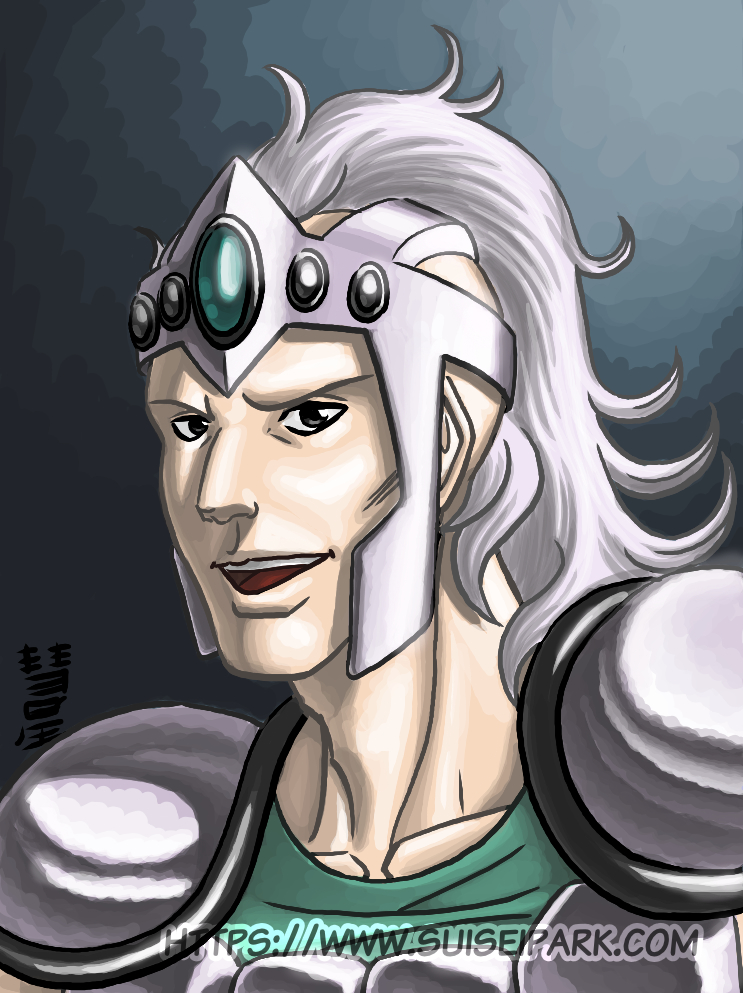
Saint Seiya, the five others bronze saints

Soccer
Collective contribution with
Renauddesign
Kevin Kapalsky
ShinKoala

Vampires
Collective contribution with
Renauddesign

Werewolves
Collective contribution with
Renauddesign
Kevin Kapalsky

Zombies
Collective contribution with
Renauddesign
Kevin Kapalsky
Khimaerai

Halloween
Collective contribution with
Renauddesign
Kevin Kapalsky

Sean Connery
Collective contribution with
Renauddesign
Kevin Kapalsky

Santa Claus
Collective contribution with
Renauddesign
Kevin Kapalsky

2020 Review
Collective contribution with
Renauddesign
Kevin Kapalsky

There weren't any theme so I chose to draw Data from Star Trek Next Generation.

WildCats vs CyberForce
Collective contribution with
Renauddesign
Kevin Kapalsky
That's all for today !
To avoid you big compilations like this it would be nice if I post each of my participation to the Drink'N'Draw immediately after finishing it and then like this I could give news in a more regular way. x)
I still have a bunch of news overdue, so I'll see you soon!
Suisei
Categories : Illustrations, News and chitchat,














